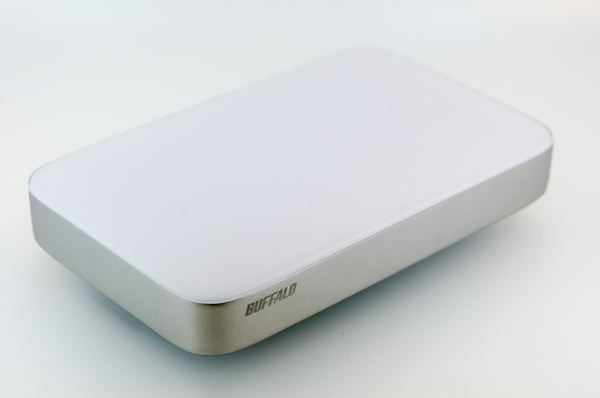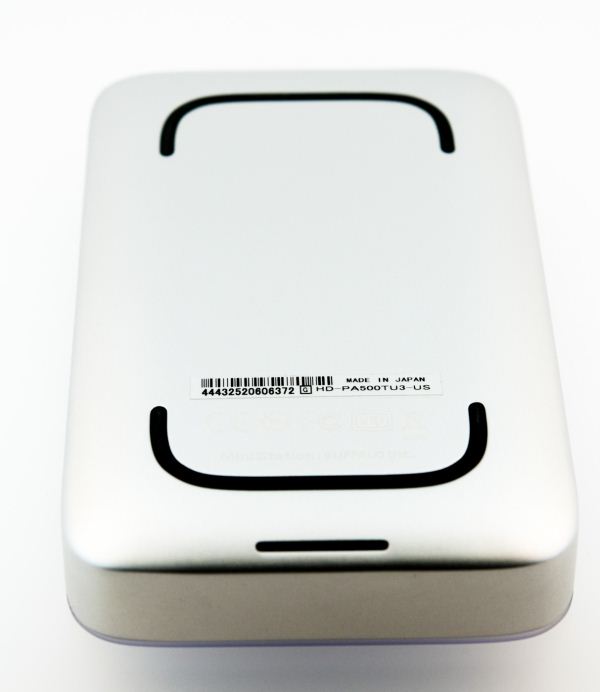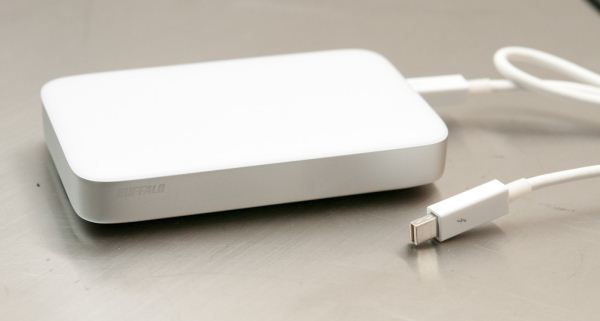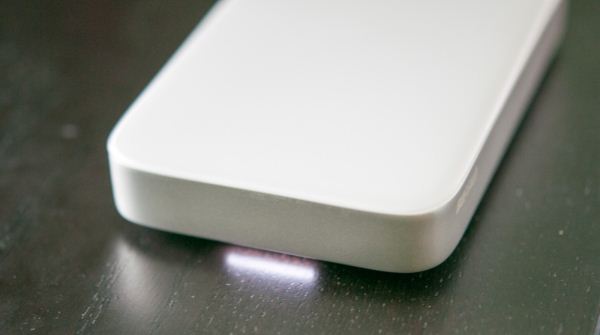Buffalo MiniStation Thunderbolt Review - An External with USB 3.0 and Thunderbolt
by Brian Klug on August 1, 2012 4:04 PM EST- Posted in
- Storage
- SSDs
- USB 3.0
- Thunderbolt
- Buffalo
Back when Thunderbolt (then Intel Lightpeak) was optical, I was actively involved in covering the interface, partly out of professional curiosity due to my optical background, partly because I sincerely believe optical interfaces are an inevitable part of the future. When Lightpeak became Thunderbolt and lost the optical layer, it fell under Anand’s beat and the Mac umbrella. I acquired a MacBook Pro with Thunderbolt somewhere around the same time, but never acquired any Thunderbolt peripherals or drives. Since then, Thunderbolt has slowly but surely gained traction with more and more peripherals and host devices. Initial adoption was glacial in part because most of the earliest Thunderbolt peripherals were really aimed at the very high end market with big RAID or JBOD stations, and partly due to what boiled down to Thunderbolt being Apple-only until just recently.
There’s an interesting story as to exactly why most of the initial Thunderbolt peripherals were aimed at such a high-end market, and some of it was purely because of both the TDP, size, and engineering constraints involved with the first generation Thunderbolt controllers. The other half of the equation is that selling external storage isn’t always the most valuable prospect, as shoppers expect commodity pricing and generally know the cost of the drive inside. Thankfully, second generation Thunderbolt controllers with smaller size, TDP, and lower cost are now the norm, and at the same time Apple has unleashed more Macs with the interface of note, meaning that there’s a bigger captive market of potentially interested shoppers.
So when Buffalo dropped us a line about an upcoming 2.5" form factor portable hard drive with both USB 3.0 and Thunderbolt interfaces, I couldn’t resist the temptation and jumped at the opportunity to review it. When it comes to single drive external Thunderbolt storage, the only real options at this point are either the Seagate GoFlex, or the new Buffalo MiniStation Thunderbolt.
The Buffalo MiniStation comes in two flavors, differentiated only in storage size. There’s a 1 TB version which runs $229.99 named the HD-PA1.0TU3, and a 500 GB version named the HD-PA500TU3 and priced at $199.99. The only difference is what drive you get inside; both include Thunderbolt and USB 3.0. Buffalo has also opted to include both the USB 3.0 and Thunderbolt cables with both MiniStations. Prior drives required the separate purchase of a Thunderbolt cable, which costs around $50. Since there are now multiple cable suppliers (whether this means the active controller in the cable, or companies cabling the system remains unknown to me), pricing has started creeping down and Buffalo was able to include both a 19.7 inch Thunderbolt cable and USB 3.0 cable.
| Buffalo MiniStation Thunderbolt | |||||
| HD-PA500TU3 | HD-PA1.0TU3 | ||||
| Storage | 500 GB HDD | 1 TB HDD | |||
| Interface | miniUSB 3.0 (2.0 legacy), Thunderbolt (no pass through), Cables Included | ||||
| Formatting | Mac (HFS+) | ||||
| Size, Mass | 3.17 x 5.12 x 0.91 (inches), 9.28 oz | ||||
| Pricing | $199.99 (newegg) | $229.99 (newegg) | |||
Since Thunderbolt is still predominantly an Apple interface (7-series boards and IVB Ultrabooks notwithstanding), the industrial design of the Buffalo MiniStation is decidedly Apple inspired. The drive is made of two main parts, a single piece aluminum can in which the drive sits, and a plastic top which snaps inside this assembly.
There’s a series of white status LEDs which shine through a diffuse rectangular chicklet cutout on the bottom front lip, which reflects up off of a surface. The indicator light breathes like an Apple power indicator when there’s activity, and stays solid when plugged in. It’s a nice take on an external hard disk status LED that I haven’t seen done before.
On the underside are two small rubber feet which actually aren’t part of the aluminum base but make contact with the drive caddy inside. Regulatory markings are laser etched near the front rubber foot. At the back of course are the Thunderbolt and USB 3.0 ports, on opposite sides of the drive.
Construction of the MiniStation is subjectively great. There’s not much flex if you squeeze the aluminum side against the plastic lip, and it feels like a solid brick of aluminum in the hand. I’ve regularly transferred videos shot on my DSLR onto the MiniStation, then tossed the drive into the main pocket of my backpack. It isn’t a super rugged design, but definitely will get the job done.





















61 Comments
View All Comments
Guspaz - Wednesday, August 1, 2012 - link
This is still a $100-130 premium over comparable USB 3 drives of the same capacity, which is just nuts. It's the same kind of markup Seagate charges (the thunderbolt goflex adapter goes for about $130).This is silly: Apple has a thunderbolt ethernet adapter out for $29, which means the cost of the controller is below $29, and you can buy a card with a PCIe SATA controller for $15. Both of those would already have markup on them for the profit margin, so the premium for a thunderbolt external HDD should be LOWER than $44... Instead the premium is almost three times higher.
PRPechek - Wednesday, August 1, 2012 - link
I would have to disagree with you. The Thunderbolt Ethernet Adapter does not have a Thunderbolt controller. At this link:http://www.hardmac.com/news/2012/06/21/inside-appl...
You can see a tear down of the TBEA and Apple is not using Intel’s Thunderbolt-to-PCIe chipset. Instead, the Broadcom chip is directly connected to the Thunderbolt cable and it is just working as a cable transport layer. By design, the Thunderbolt "controller" is actually mapping one or more PCI-Express lanes directly over the cable, so that the MAC+PHY solution itself only needs speak PCI-Express and only requires the Thunderbolt PHY.
Note: that I cut and pasted almost all of the above from Stephen Foskett great breakdown of the TBEA chipset. http://blog.fosketts.net/2012/07/03/apple-thunderb...
But as you can see on the second page of this review Buffalo has a quite a few chipsets imbeded into the PCB to make a workable dual port solution and that raises that raises the BOM costs. Seagate's solution has a similar situation with their solution.
(Full disclosure: I work for Buffalo Technology)
Olaf van der Spek - Wednesday, August 1, 2012 - link
So why can't you do a TB - SATA bridge without TB controller as well?What's the advantage of TB over USB3 if you merely want to connect a single HDD?
ggathagan - Wednesday, August 1, 2012 - link
Your first question is not clear.TB requires a TB controller on both ends of the cable, so the TB controller is going to be there no matter what.
Intel is the only company that makes TB controllers, so how would you create a TB-SATA bridge without the controller?
There's no advantage to TB over USB3, unless you have a MacBook Air, MacBook Pro, Mac mini, or iMac that has no USB 3 support.
name99 - Wednesday, August 1, 2012 - link
"There's no advantage to TB over USB3"It appears that there is a substantial speed advantage --- almost 2x.
Look at the numbers: 200MB/s or so for sequential USB3, 370 MB/s or so for sequential TB.
This may or may not be worth $130 to you, but let's not pretend that the two are identical.
Lonyo - Thursday, August 2, 2012 - link
You must be missing the part where that only applies to an SSD put in after the fact.With the stock drive which comes as part of the unit, the speeds are equal at around 115~120MB/s.
There is no performance difference between this drive when used with Thunderbolt, and when used with USB3.
And if you're getting an SSD to put in an enclosure, the difference becomes the difference between an empty USB3 enclosure, and one of these, which means it's more like $170+, since you can get an empty USB3 eternal enclosure for around $30, while you can't get just a Thunderbolt enclosure, so you have to pay $200 for the 500GB drive.
As shipped, with a mechanical harddrive in it, this drive is identical in performance to a USB3 external enclosure with no Thunderbolt. And $110+ more expensive.
lin2log - Thursday, August 2, 2012 - link
And you must be missing (actually ignoring) the very simple original question: "What's the advantage of TB over USB3", which I don't see somehow applies to any one disk or peripheral, but rather is about the port ITSELF, so your insertion is completely irrelevant.But I like how the question is quickly limited to "if you merely want to connect a single HDD", which makes it a nonsensically loaded question.
Simple: if you don't see the advantages for you... DON'T USE IT. Duuuuh...
ssj3gohan - Thursday, August 2, 2012 - link
You seem to imply that his comments are not valid, but that is not true at all. He has extremely valid points. What use is a proprietary interface with monstrously expensive interconnects, controllers, almost no second suppliers and no performance, power consumption, ANY advantage whatsoever? You're just paying a hell of a lot more for nothing. It's a big design flaw on Apple's side that there is apparently no USB 3 on some of their products, because that interface is obviously far superior except for some niche applications. They can promote the niche applications, sure, just make sure you can also plug in more conventional stuff. That's what expandability is all about.mavere - Thursday, August 2, 2012 - link
"What use is a proprietary interface with ... almost no second suppliers and no performance, power consumption, ANY advantage whatsoever?"Patently false. As you have the benefit currently reading a TB review, you may scroll up and look at the SSD numbers.
Cheers.
AnnonymousCoward - Thursday, August 2, 2012 - link
ssj3gohan is 1000% correct.